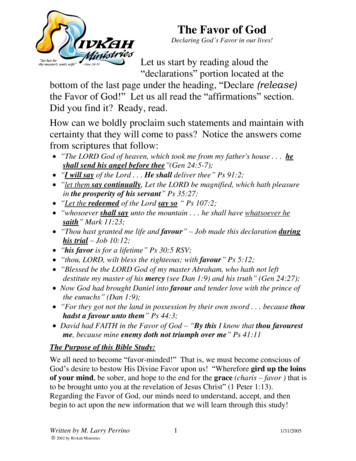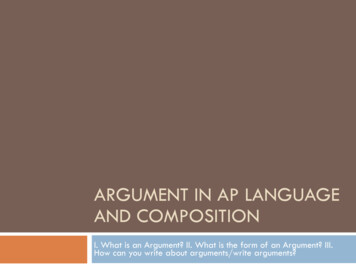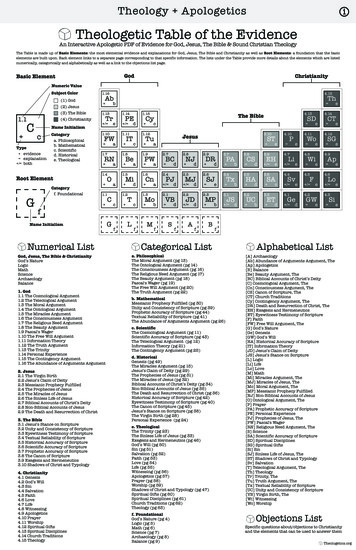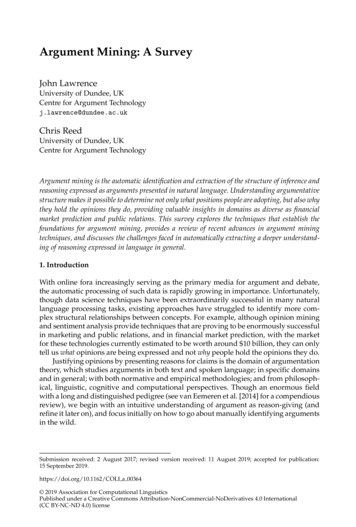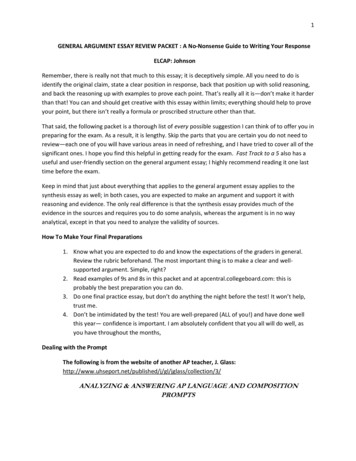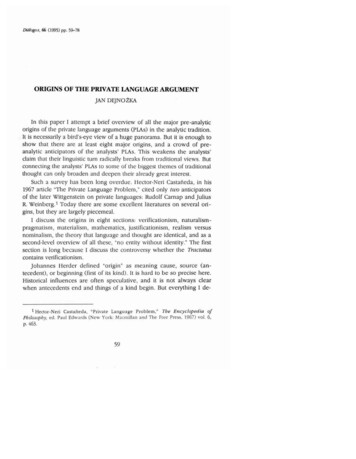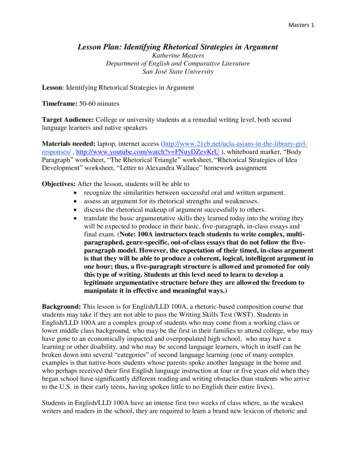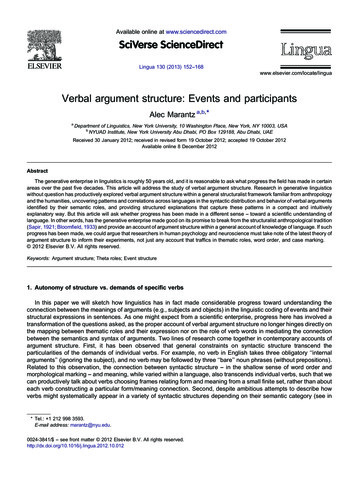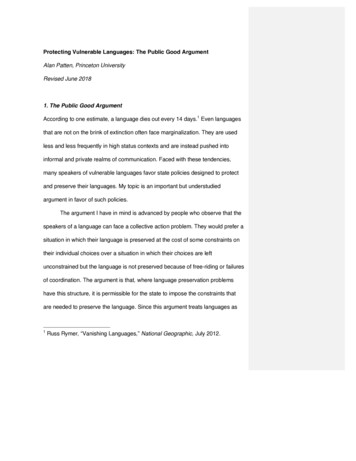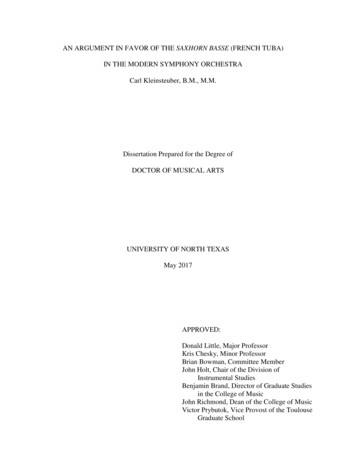
Transcription
AN ARGUMENT IN FAVOR OF THE SAXHORN BASSE (FRENCH TUBA)IN THE MODERN SYMPHONY ORCHESTRACarl Kleinsteuber, B.M., M.M.Dissertation Prepared for the Degree ofDOCTOR OF MUSICAL ARTSUNIVERSITY OF NORTH TEXASMay 2017APPROVED:Donald Little, Major ProfessorKris Chesky, Minor ProfessorBrian Bowman, Committee MemberJohn Holt, Chair of the Division ofInstrumental StudiesBenjamin Brand, Director of Graduate Studiesin the College of MusicJohn Richmond, Dean of the College of MusicVictor Prybutok, Vice Provost of the ToulouseGraduate School
Kleinsteuber, Carl. An Argument in Favor of the Saxhorn Basse (French Tuba) in theModern Symphony Orchestra. Doctor of Musical Arts (Performance), May 2017, 33 pp., 9figures, bibliography, 30 titles.The French tuba was a much-needed addition to the brasswind musical instrumentfamily, adding depth, projection and a unique color to French orchestral literature. Its ancestorsthe serpent and ophicleide both lacked the tonal stability and sonic power to adequately presentthe bass wind role in a robust orchestra. Through the efforts of its developer and patent-holderAdolphe Sax, the French tuba made converts among players and composers, effectively creatingits own niche in music history. Musical tastes change however, and the French tuba has beenlargely supplanted by tubists using instruments twice its size. Since French composers composedspecifically with the distinct timbre of the French tuba in mind, this unique and characteristicmusical entity deserves a resurgence in performances of French orchestral repertoire.
Copyright 2017ByCarl Kleinsteuberii
TABLE OF CONTENTSPageCHAPTER 1. INTRODUCTION . 1CHAPTER 2. TUBA SIZES, NOMENCLATURE, AND THE EUPHONIUM: BASICDEFINITIONS . 10CHAPTER 3. ORCHESTRAL REPERTOIRE CHOICES FOR THE FRENCH TUBA:HISTORY AND PERFORMER’S EXPERIENCE . 12CHAPTER 4. DIFFERENCES BETWEEN THE FRENCH TUBA AND THE EUPHONIUMAND WHICH IS THE MOST APPROPRIATE INSTRUMENT FOR FRENCHORCHESTRAL REPERTOIRE . 20CHAPTER 5. NECESSARY COMPROMISES AND CONSIDERATIONS IN INSTRUMENTAND MOUTHPIECE CHOICE REGARDING THE FRENCH TUBA FOR USE IN FRENCHORCHESTRAL REPERTOIRE . 25CHAPTER 6. CONCLUSIONS . 30BIBLIOGRAPHY . 32iii
CHAPTER 1INTRODUCTIONThe saxhorn basse or French tuba (hereafter referred to as the French tuba) was a uniqueand flavorful ancestor of the modern-day tuba which attracted the ear of French composersbetween 1843 and the 1960s. The current trend among many modern symphonic tubists is to usea tuba twice the length of the original French tuba when playing French repertoire. This ismusically unjustifiable, and I intend in my lecture/recital to demonstrate the unique timbralcharacteristics of the French tuba in comparison to the larger bass- and contrabass tubas whichhave supplanted it, and demonstrate the French tuba’s continued worth to the musical world. TheFrench tuba deserves a reintroduction into the orchestral world.The first conical valved bass brasswind instruments (tubas) were patented in 1835 byPrussian instrument builders Wilhelm Wieprecht and Johann Moritz. These new instruments werepitched in 12-foot F and were intended as a replacement for the bass trombone. 1 They wereessentially ophicleides with chromatic valves instead of keys. Although the early tubas featured anarrow bore and an extremely small bell, they were by all accounts superior in terms of volume,range of attainable pitches, intonation and projection in comparison to their predecessors, theophicleide and serpent. The valves of these early tubas were of the Berlinerpumpen type, whichwere the forerunners of the modern piston valve. Tubas in a variety of shapes and keys werequickly adopted throughout Europe by composers, ensembles and players alike.1Harvey Phillips and William Winkle, The Art of Tuba and Euphonium (Secaucus, New Jersey: Summy-Birchard,1992), 5.1
Figure 1 Wieprecht-Moritz tubaAlthough the tuba found its beginnings in Prussia, its design was quickly copied andrevised as needed as the instrument’s design crossed European borders. Opportunity was abundantfor instrument makers, especially in Paris which had been a seat of culture for centuries. AntoineJoseph “Adolphe” Sax (1814-1894) was a Belgian instrument maker who was drawn to Paris. 2Shortly after his arrival in Paris in 1842, Sax invented a family of valved, conical brasswindinstruments called the saxhorns. Sax’s intent was to create a family of like-timbred brasswindinstruments which could cover a very large range of musical pitches homogenously. In France andEngland, instruments similar to the saxhorns were pitched largely in B-flat and E-flat alternately,and in Czech/Germanic countries they were predominantly developed in B-flat and F. 3The larger bass members of the saxhorn family which assumed the tuba’s role in Frenchorchestras include the saxhorn basse and the nouveau saxhorn basse (hereafter both referred to as2Stephen Cottrell, The Saxophone, The Yale Musical Instrument Series (New Haven: Yale University Press, 2013),15.3Cecil Forsyth, Orchestration (New York: Dover Publications, 1982), 163.2
the French tuba, as is the custom in English-speaking countries). They were valved, conicalbrasswind instruments in either 8-foot C or 9-foot B-flat, the C version being predominant in anorchestral setting. 4 The nouveau saxhorn basse model of French tuba was fitted with as many assix independent piston valves in order to enable the musician to play chromatically down to thepedal register. Some also had an easily-moved main tuning slide in the leadpipe for ease of tuningadjustment. While Sax’s workshop also introduced a model of contrabass saxhorn in 18-foot Bflat, it ceased production in 1868, apparently due to lack of interest. 5The utilization of the French tuba reached its zenith in the latter half of the 19th century.This was the instrument used by tubists in France and certain other European countries fromaround 1843 up to approximately 1960, at which time foreign influences and the pervasive effectof orchestral recordings had gradually caused a homogenization of orchestral timbres around theworld, and finally drove the French tuba from orchestras, seemingly for good.The French tuba proliferated in late nineteenth- and early twentieth century Paris partlybecause French composers sought an orchestral ensemble full of strong individual timbres, eachwith its own clear aural identity. This attitude contrasts a more Germanic/Austrian approach toensemble sonorities such as that of Anton Bruckner, where the entire group is meant to combine,often entering as tutti instrumental groups and even emulating the pipe organ. The CambridgeCompanion to the Orchestra says that “ lack of blend was particularly marked in Frenchorchestras, in which individual instruments tended to be quite distinct from each other in tone-4Joseph Vaillant, “The Evolution of the Tuba in France,” T.U.B.A. Journal, Vol. IV no. 3 (Spring/Summer 1977):17.5Evgenia Mitroulia, “Adolphe Sax’s Brasswind Production with a Focus on Saxhorns and Related Instruments”(PhD diss., University of Edinburgh, 2011), 165, accessed January 15, 2017, http://hdl.handle.net/1842/5490.3
colour.” 6 This same source goes on to describe the tonal colors of French brass players as“pungent” which to the experienced listener seems an apt description. Virgil Thomson once wroteof the French orchestral approach to timbres that “the French orchestral style is one of equilibration[sic], of clear balances and clean colors, of poetic luminosity rather than of animal warmth. Andthe whole repertoire of French music composed since Berlioz is designed to profit by this delicateperforming style.” 7 Leonard Bernstein in his renowned Young Peoples’ Concerts described theFrench orchestral sound as “thin, transparent, delicate.” 8 Henry Dutilleux used the term sitesauriculaires – or “points of beauty for the ear” to describe the French approach to orchestration. 9Clifford Bevan remarks:French composers up to the Impressionists and beyond were much more interested in theprecisely calculated differences given by woodwind and brass which, while relativelynarrow-bored by German standards, differed much more one from the other. On Debussy’spalette the tones of horns and trombones, for example, could never be confused in the waythey might on Bruckner’s. Each instrument had a completely individual voice, the tubaequally with the others, and it was adequate to support the trumpets and trombones. 10From all the preceding remarks, we quickly get the clear impression that French composersused brass instruments for sonority rather than weight, in contrast to Germanic music. The Frenchtuba’s unique tone color admirably fulfilled this tendency of French composers to promoteindividuality in orchestral instrumental voicings. Yet despite the instrument’s unique suitabilityfor this repertoire, that timbre is in danger of disappearing entirely today.6Robert Philip, “Historical Recordings of Orchestras,” Chap. 12 in The Cambridge Companion to the Orchestra,Cambridge Companions to Music, ed. Colin Lawson (Cambridge, U.K.: Cambridge University Press, 2003), 209.7Virgil Thomson and Tim Page. The Library of America. Vol. 258, Virgil Thomson: Music Chronicles, 1940-1954.New York, N.Y.: The Library of America, 2014.8Leonard Bernstein, “Young Peoples Concert”, accessed January 15, 2017,http://www.leonardbernstein.com/ypc script the sound of an orchestra.htm9Henri Dutilleux. Music – Mystery and Memory, Conversations with Claude Glayman, trans. Roger Nichols(Aldershot: Ashgate, 2001), 20.10Clifford Bevan, The Tuba Family, 2nd ed. (Winchester: Piccolo, 2000), 347.4
Another reason for the French tuba’s proliferation was Sax’s abilities as a salesman andpromoter. In 1845, the French king Louis-Philippe and his advisors had become concerned at thestate of French military music, especially in comparison to Germany’s military musicestablishment. They sought to revamp and revitalize the French military music program andproposed a contest to determine who would receive the contract to provide new instruments forthe entire French military. A battle of bands was organized, and the Bataille des Saxons et desCarafons was held in April 1845 on the Champ de Mars with 20,000 Parisians in attendance.Judged primarily by the standards of intonation and sheer volume, Sax’s saxhorn-based band wonhandily, and he was awarded the lucrative contract. This was a financial boon for his workshop,and the production and use of saxhorns increased greatly. 11With the addition of many new clients, Sax’s workshops sold 20,000 instruments between1843 and 1860. 12 The proliferation and popularization of the saxhorn was further aided by the factthat Sax served as a stage band (or banda) director at the Paris Opéra from 1847 until 1892, whenhis son took over this function from him. 13 This gave Sax an opportunity to work closely withcomposers and conductors, and to influence orchestration and instrumentation of upcomingproductions. The banda was “to some extent independent of the main orchestra, with their directorfrequently called upon to score music for the ensemble according to the composer’s wishes.” 14 Asa result of his influential position at the Opéra, Sax was able to convince a number of composersto include saxhorns in their works, either in the banda backstage, onstage, or in the main pit11Albert R. Rice, From the Clarinet d'amour to the Contra Bass: A History of Large Size Clarinets, 1740-1860(Oxford: Oxford University Press, 2009), 302.12Stephen Cottrell, The Saxophone, The Yale Musical Instrument Series (New Haven: Yale University Press, 2013),97.13Stewart Carter, Bucina, vol. 6, Brass Scholarship in Review: Proceedings of the Historic Brass SocietyConference, Cité de La Musique, Paris, 1999 (Hillsdale, NY: Pendragon Press, 2006), 138.14Cottrell, 103.5
orchestra. Some of these operas including saxhorns are la Tribut de Zamora (1881) by CharlesGounod, le Roi de Lahore (1877) and Le Mage (1891) by Jules Massenet, Hamlet (1868) andFrançoise de Rimini (1882) by Ambroise Thomas, Le prophète (1849) and Robert le Diable (1848)by Giacomo Meyerbeer, and Robert Bruce (1847) by Gioachino Rossini. 15 Meyerbeer was aparticularly avid fan of Sax’s saxhorns. His opera Le Prophète had eighteen saxhorn parts, and hisopera L’Africaine had twenty saxhorn parts. 16 It has been calculated that during the period from1847 to 1877, from the seventeen productions using banda, 59% of those scores requiredinstruments invented by Sax. 17 He essentially created a market- and a place in music history forhis own musical inventions.Throughout ensuing decades, the French tuba was almost without exception the onlymember of the tuba family employed in French orchestras. The relatively small French tubaremained popular in France despite the increasing popularity elsewhere of the larger German tubasfor several reasons. First, the keys of French tubas in 8-foot C and bass saxhorns in 8-foot B-flatmirrored exactly the keys of their predecessors the ophicleides and serpents, so could be used toplay pre-existing repertoire, both in solos and in ensembles. The serpents and ophicleides weremost commonly pitched in 8-foot C and 9-foot B-flat respectively, and parts were often written fortwo instruments together, one in each key in order to cover any shortcomings one instrument mighthave in a particular key in terms of tuning or resonance. Since the French tubas were in the samekeys as their predecessors, this was also seen as a continuation of tradition. Second, music inFrance of this era revolved largely around the theater, and somewhat smaller timbres fit better in15Carter, 140.16Robert Ignatius Letellier, Meyerbeer Studies: A Series of Lectures, Essays, and Articles on the Life and Work ofGiacomo Meyerbeer (Madison, N.J.: Fairleigh Dickinson University Press, 2005), 206.17Carter, 140.6
the theater venues. Third, the larger tubas were of German origin, and the French were loath toupend their own cultural conventions in favor of instruments from a country which had alwaysbeen their hereditary rivals. Robert Tucci writes that use of the French tuba in France was partlydue to “nationalistic considerations.” 18 For all these reasons, French conservatories requiredstudents to study the French tuba as their main tuba instrument, and only added the study of largertubas in lower keys since the 1960s, and this only as a sideline. Indeed, renowned French tubistMichel Godard began his tuba studies on the French tuba at the Besançon Conservatoire as late as1978. 19 The Paris Conservatory currently has a class of six saxhorn/euphonium students as well asa class of six students studying bass- and contrabass tubas. 20From personal correspondence with French professional musicians who still use saxhorns,French tubas, serpents and ophicleides in a variety of venues, 21 it becomes apparent that the Frenchtuba’s decline in use is largely to blame on the “shrinking world” effect: the emergence of highfidelity recordings in the middle of the twentieth century led to a homogenization of orchestraltimbres and playing styles around the globe, and a consequent loss of local color and tradition.Also at this same time, conductors traveled more extensively than ever before, often guestconducting week to week at different orchestras. They would bring their own expectations withthem from previous weeks’ experiences, and often would not encourage the local traditions of thecurrent week’s ensemble. Beginning in the 1960s, visiting conductors came to France andsometimes requested the larger tubas in 12-foot F, 16-foot C, or 18-foot B-flat be used for variousrepertoire. Wibart and the members of the Opus333 saxhorn quartet tell of a specific incident. In18Robert Tucci, “The Tuba in Europe”, T.U.B.A. Newsletter I, no. 1 (Fall 1973): 319Clifford Bevan, The Tuba Family, 2nd ed. (Winchester: Piccolo, 2000), 345.20Patrick Wibart (Opus333 professional saxhornist), Facebook correspondence with author, January 2017.21Wibart, January 2017.7
1959, renowned Wagnerian conductor Hans Knappertsbusch was guest-conducting a productionof Wagner’s Ring cycle at the Paris Opéra. He requested that tubist Jean-Baptiste Marie not usehis French tuba for the production, but a contrabass tuba in 18-foot B-flat instead. Marie balkedbut ultimately managed to negotiate a permanent 75% salary increase from his employers inexchange for his use of the larger tuba. This premium became standard for French tubists’ use ofbass- and contrabass tubas, and remained in force until the players’ retirement, so only endedgradually in France over a period of decades. What made players such as American expatriate MelCulbertson attractive upon his arrival in France was that he was already familiar with the largertubas, and was happy to use them without need for the 75% premium. Mr. Culbertson wasappointed to the tuba position in the Nouvel Orchestre Philharmonique of Radio France in the1970s. 22 He had studied with American tubists Roger Bobo, Harvey Phillips and Arnold Jacobs,so was accustomed to the American custom of using the larger tubas, and he imported this customwhen he moved to France. He was also one of my predecessors in my position as solo tubist of theHague Philharmonic, where he most often played a large contrabass tuba in 16-foot C.Aside from orchestral repertoire which helped keep the French tuba active in France, therewere a number of composers who actively and enthusiastically wrote solo literature for theinstrument. Eugène Bozza, Jacques Castérède, Joseph Edouard Barat, and Henri Tomasi allcomposed for the French tuba, although their works were often listed for other low-brassinstruments such as the bass trombone as well. Typical of this, Tomasi’s Danse Sacrée is inscribedfor “Tuba Ut ou Trombone ou Saxhorn basse Si- .” By and large, the character of French lowbrass solo repertoire was light and virtuosic.22Trevor Herbert and John Wallace, eds., The Cambridge Companion to Brass Instruments, CambridgeCompanions to Music (Cambridge: Cambridge University Press, 1997), 155.8
Although lack of demand caused the French tuba to cease being produced in the 1980s,they may be making a resurgence. Willson Band Instruments of Switzerland recently resurrecteda model for production: the “Willsax”23, a compensating saxhorn in 9-foot Bb which has beenadopted and championed by the saxhorn quartet Opus333 24. To date however Willson has soldless than twenty of these instruments. 25 Major orchestras (Philadelphia Orchestra, 2003; ChicagoSymphony, 2008 26) will occasionally demonstrate a genuine French tuba as a peculiarity, but onlyin order to demonstrate the Bydlo solo from the Mussorgsky/Ravel Pictures at an Exhibition. Theydo not however use the instrument for the entire work as Ravel intended. As a proponent andperformer of the French tuba, I regularly used an original 1931 Couesnon French tuba in 8-foot Cin my duties as solo tubist of the Residentie Orkest/Hague Philharmonic of the Netherlands onrepertoire by composers such as Debussy, Mendelssohn, Berlioz, Franck, Messiaen and Ravel, andunder conductors such as Jaap van Zweden, Neeme Järvi and Evgeny Svetlanov.23Willson Saxhorn, accessed January 15, 2017, uor de Saxhorns Opus333, accessed January 15, 2017, http://www.opus333.com/.25Wibart, Facebook correspondence January 31, 2017.26Chicago Symphony Orchestra, Sounds and Stories, accessed January 15, ky-pictures-from-an-exhibition-pictures-of-what/ 35:159
CHAPTER 2TUBA SIZES, NOMENCLATURE, AND THE EUPHONIUM: BASIC DEFINITIONSSince the tuba’s invention in 1835, a degree of confusion has come to exist because manydifferent instruments have been referred to as “the tuba” despite a wide variety of designs. Namingconventions varied across borders and between languages. More recent tubas can be found in thefollowing varieties: Contrabass tubas: These are pitched in 18-foot B-flat or 16-foot C. They generally havea broad and dark tone. These instruments are commonly used in larger ensembles. Bass tubas: These instruments are pitched in 13.5-foot E-flat or 12-foot F. They aregenerally more musically nimble and lyrical and have a lighter tone than the contrabass tubas, andare often used for solos or work in smaller ensembles. Bass saxhorn: A member of Sax’s family of conical brasswind instruments, the saxhornbasse was usually in 9-foot B-flat, and used almost exclusively in bands and wind ensembles.Nomenclature becomes confusing however because the variant in 8-foot C known in France as thenouveau saxhorn basse with 5 or 6 independent valves was the instrument used in orchestras andwhich eventually became known as the French tuba. French composer and organist Charles Widorwrote of the saxhorns “It would be well to admit the Saxhorn group into our orchestra. Thisperfectly homogeneous mass, with a total compass of five octaves, would serve as a firm andmellow background for the brilliant flourishes of the Trumpets and Trombones. It would serve asa foil rather than as an element of combination with them.” 27 The euphonium: This instrument is pitched in 9-foot B-flat and has a sweet singing27Charles Marie Widor, The Technique of the Modern Orchestra: A Manual of Practical Instrumentation - PrimarySource Edition (Charleston, South Carolina: Nabu Press, 2014), 91.10
quality. Although the euphonium’s lineage comes directly from the saxhorn family, the firstinstrument bearing this name was developed by Ferdinand Sommer of Weimar, Germany with theassistance of Franz Bock who filed the patent for the “euphonion” in 1844. Sommer also calledthe instrument the Sommerphone, but ultimately the name “euphonion” was Anglicized to“euphonium.” 28 The instrument was popularized in the United Kingdom by Henry Distin who wasunder contract to Adolphe Sax. The popularity of the performances by Distin and his family arecredited with the beginning of the brass band movement in the United Kingdom. 29 The French tuba: This instrument is also known as the saxhorn basse, the tuba en Ut,and the French tuba in the English-speaking world. These instruments were pitched in 9-foot Bflat and 8-foot C. Around 1860, variants were produced of the C models with as many as sixindependent valves in order to aid production of low notes and make the instruments able to playchromatically down to the pedal register. This variant is known as the nouveau saxhorn basse, butstill is known as the French tuba. This is the instrument which remained in use until approximately1960 in French orchestras and conservatories.All of these instruments fit the description of the term “saxhorn.” Matters of nomenclaturebecome complicated, however, because Sax essentially patented an instrument which alreadyexisted: a conical valved brasswind instrument. In fact, his patent claim was so tenuous that hewas immediately sued by a plethora of other European instrument designers who rightly claimedthat there was nothing unique or new about his saxhorns. 30 The lawsuits dragged on for years,ultimately driving many of his competitors out of business.28Lloyd E. Bone, Eric Paull, and R Winston Morris, eds., Guide to the Euphonium Repertoire: The EuphoniumSource Book, Indiana Repertoire Guides (Bloomington: Indiana University Press, 2007), 7.29Ray Farr, The Distin Legacy: The Rise of the Brass Band in 19th-Century Britain (Newcastle upon Tyne:Cambridge Scholars Publishing, 2013), xi.30Anthony Baines, Brass Instruments: Their History and Development (New York: Dover Publications, 1993), 255.11
CHAPTER 3ORCHESTRAL REPERTOIRE CHOICES FOR THE FRENCH TUBA:HISTORY AND PERFORMER’S EXPERIENCEOnce a tubist has obtained a position of tenured employment in an orchestra, the choice ofwhich instrument to use for specific repertoire is largely his to make, taking into consideration thewishes of both the music director and to a lesser extent the wishes of the colleagues in the trombonesection. While the choice of instrument is commonly driven by a player’s subjective personaltastes, ideally it is also motivated by objective considerations of the composers’ intent andhistorical context. The tubist must arm himself with knowledge about the predecessors of themodern tubas, as it is not unheard of to be presented with published parts marked “ophicléidemonster à pistons” or “bombardon” and so forth. It is the responsibility of the musician to knowwhat these instruments are, their respective roles, and to make informed decisions as to whichinstrument to choose in each situation in order to best carry out the wishes of the composer.Especially in American orchestras, there has been a trend over the last decades of using the largesttuba possible for any and all repertoire, regardless of the express wishes of the work’s creator. Iexperienced this firsthand when engaged by high-profile ensembles to perform as second tubist onworks such as Berlioz’ Symphonie Fantastique or Stravinsky’s the Rite of Spring. I was sometimesasked by the principal tubist to bring the largest tuba possible. The most cursory musico-historicalinvestigation will reveal that this is not what these composers intended.1. Pictures at an Exhibition (1922) Modest Mussorgsky (1839-1881), arranged byMaurice Ravel (1875-1937)The Bydlo movement of this work is a tremendous showcase for the French tuba. Itmusically depicts an oxcart and its driver trundling in from the distance, passing by the observerand receding once again away into the distance. The current trend is that either the tubist performs12
this solo on a bass tuba in 12-foot F, or the solo is given to a euphoniumist to play, as it is quitehigh and risky for the larger tubas.Figure 2 "Bydlo" movement from Ravel's "Pictures at an Exhibition,” tuba partRavel intended, however, that all movements of Pictures be played on the French tuba. The restof the part makes extensive use of the large compass of the French tuba. The following excerpt isplayed in octaves with the bass trombone and illustrates the wide range required of the Frenchtuba.Figure 3 Third Promenade from Ravel's "Pictures at an Exhibition,” tuba partIt was standard practice in France until around 1960 to play the entire work on the French tuba. 31Ravel’s arrangement makes full use of one of the French tuba’s strongest points: its ability tonavigate a large number of octaves with relative ease.31André Cluytens conducting the Orchestre National de France, August 1960.https://youtu.be/rp-vIzUbK-c(accessed January 15, 2017)13
2. Symphony in D minor (1888) .C. Franck (1822-1890)Although César Franck was born in Belgium, he was from a portion of Belgium known asWalloonia where French is spoken and where French culture is strongly represented. Most ofFranck’s productive adult life was spent in Paris, so he would have heard the French tubafrequently and been influenced by Parisian composers. Franck’s Symphony is full of sumptuous,tuneful melodies written in a resonant range for the French tuba. Bevan writes that this symphonybest sums up the French school’s unique approach to brass writing. 323.Symphony No. 3 “Organ Symphony” (1886) C. Saint-Saëns (1835-1921)Although originally commissioned by the Royal Philharmonic Society in England, thiswork is typically French: lush with sweeping melodies showcasing the individual timbres of theinstruments of the orchestra.4.A Midsummer Night’s Dream (1826) .Felix Mendelssohn (1809-1847)This work was written for the serpent. Mendelssohn composed often for the serpent, andin a variety of contexts. In the overture to A Midsummer Night’s Dream, the serpent is alone;neither trumpets nor trombones play in this movement. The serpent lines are soloistic andexpressive, at one point meant to portray the character from Shakespeare’s play named Bottom,who is transformed into a donkey. Mendelssohn also composed often for the serpent in unisonwith the contrabassoon which produces an octave effect, as the contrabassoon is a transposinginstrument. This is a clever means of providing a strong bass-wind sonority, as the tuba had yet tobe invented. Mendelssohn again uses this same technique in Meeresstille und glückliche Fahrt as32Bevan, 34914
well as in his Symphony No. 5 “Reformation.” I have performed the “Reformation” Symphonyunder the baton of Neeme Järvi. He was quite insistent that I sit next to the contrabassoon, as if Iwas an extension of the woodwind family. Bevan notes that Mendelssohn uses the serpent in avariety of ways in his oratorio Paulus, opus 36 (1836). Sometimes the serpent is listed in the scoreafter the bassoons as if it was a woodwind, and at other points in the score the serpent is listed afterthe trombones, suggesting a brass role. Bevan also suggests that Mendelssohn’s writing for theserpent may have influenced Richard Wagner to use the serpent in Rienzi. 335. Romeo and Juliet (1839) .Hector Berlioz (1803-1869)The opening recitative with the trombones is a showpiece of Berlioz’s writing for low brassinstruments. The unison theme played by the trombones together with the tuba musicallyrepresents the intervention of the stately Prince of Verona between battling Montagues andCapu
a tuba twice the length of the original French tuba French repertoire. when playingThis is musically unjustifiable, and I intend in my lecture/recital to demonstrate the unique timbral characteristics of the French tuba in
